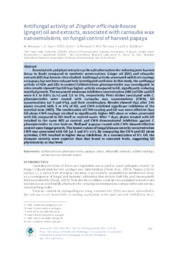Antifungal activity of Zingiber officinale Roscoe (ginger) oil and extracts, associated with carnauba wax nanoemulsions, on fungal control of harvest papaya.
Antifungal activity of Zingiber officinale Roscoe (ginger) oil and extracts, associated with carnauba wax nanoemulsions, on fungal control of harvest papaya.
Autoria: MIRANDA, M.; SUN, X.; ASSIS, O. B. G. de; FERENCE, C.; FERREIRA, M. D.; BALDWIN, E. A.
Resumo: ABSTRACT: Essential oils and plant extracts can be safe alternatives for reducing post-harvest decay in foods compared to synthetic preservatives. Ginger oil (GO) and ethanolic extracts (GE) has been in vitro studied. Antifungal activity associated with fruit coatings on papaya has not been exhaustively investigated until now. In this study, the antifungal activity of GOs and GEs to control Colletotrichum gloeosporioides was investigated. In vitro results showed that GO has higher activity compared to GE, significantly reducing mycelial growth. The measured minimum inhibitory concentration (MIC) of GOs and GE were 0.1 to 0.8% (v/v) and 2.5 to 5%, respectively. Petri dishes inoculated with C. gloeosporioides were coated with carnauba wax nanoemulsion (CWN), GO nanoemulsion (at 3 and 6%), and their combination. Results showed that after 24h plates treated with 3 or 6% of GO, and CWN exhibited significant inhibition of the mycelial zone (MZI). The combination of CWN coating and GO was more effective than GO alone. CWN coatings resulted in significantly higher MZI alone or when associated with GO, compared to GO itself or control-water. After 7 days, plates treated with GO resulted in the same MZI as control, and CWN demonstrated inhibition against C. gloeosporioides. In vivo tests on ?Redland? papayas coated with CWN showed effective control upon fungal growth. The lowest values of fungal disease severity occurred when CWN was associated with GO (at 3 and 6% v/v). By comparing the CWN and GO alone activities, CWN resulted in higher decay inhibition. At a concentration of 6% GO, the diseases severity were superior than that found in uncoated fruits, suggesting GO phytotoxicity at that level.
Ano de publicação: 2021
Tipo de publicação: Artigo de periódico
Unidade: Embrapa Instrumentação
Observações
1 - Por padrão são exibidas publicações dos últimos 20 anos. Para encontrar publicações mais antigas, configure o filtro ano de publicação, colocando o ano a partir do qual você deseja encontrar publicações. O filtro está na coluna da esquerda na busca acima.
2 - Para ler algumas publicações da Embrapa (apenas as que estão em formato ePub), é necessário ter, no celular ou computador, um desses softwares gratuitos. Sistemas Android: Google Play Livros; IOS: iBooks; Windows e Linux: software Calibre.
Acesse outras publicações
Acesse a Base de Dados da Pesquisa Agropecuária (BDPA) para consultar o acervo completo das bibliotecas da Embrapa.

